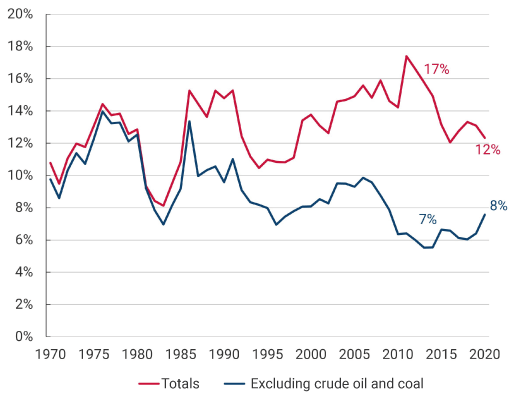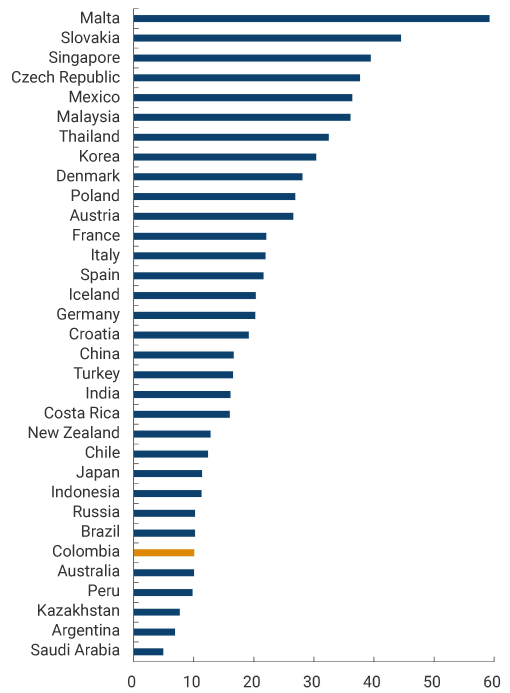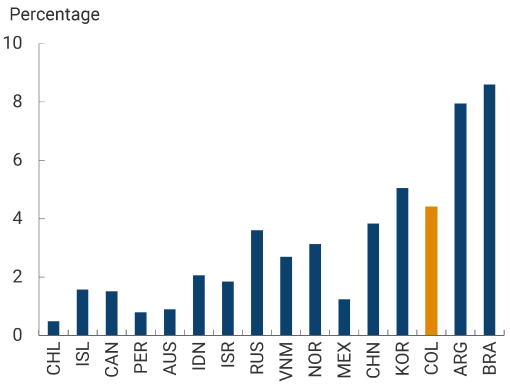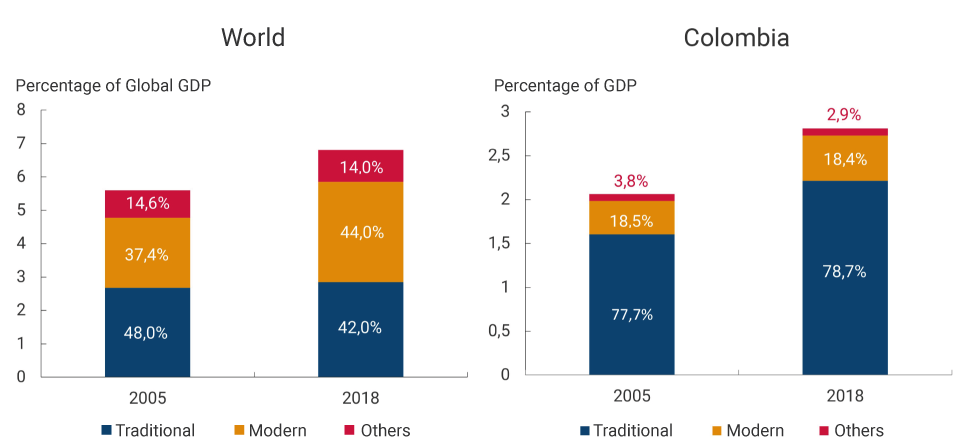The Internationalization Mission convened by the National Government with the participation of renowned international experts, the technical secretariat of the National Planning Department (DNP in Spanish), and other entities1 delivered its conclusions in August 2021. An analysis of these results shows that there are significant similarities between them and the findings from a study done by researchers from Banco de la República published in the Revista de Ensayos sobre Politica Económica (Journal of Economic Policy Essays) (ESPE) in July 2020, ESPE 95.
A first common conclusion underlines the deficiency of the country's export capacity. With respect to that, the Bank's work shows that, as a share of GDP, Colombia's exports do not show a growth trend over the long term as illustrated by the red line in Graph 1. The progress achieved during the 2000-2010 decade was due to the increase in exports of crude oil and coal, which benefited from the higher prices and the increase in the quantities exported. However, excluding these two products, it is clear that the rest of the exports remained stagnant as shown by the blue line. With the drop in oil prices after 2014, the expansion of total exports came to a halt, and this brought the export share of the GDP back to levels registered in the mid-1990s before the oil expansion began. The Mission illustrates this phenomenon by means of a regression between per-capita exports and per-capita GDP. Here Colombia is well below the trend line. From this, the Mission concludes that Colombia exports less than it should export given the size of its GDP and population.
Graph 1
Exports as a Share of GDP

Source: The World Bank (GDP in US dollars at current prices) and Banco de la República (exports – balance of payments).
A second common conclusion is that Colombia's participation in global value chains is low in comparison to other countries. As can be seen in Graph 2, the share of external value added to Colombian exports is at the bottom of the international ranking. One of the reasons for this is the high concentration of Colombian exports in natural resources. This limits the incorporation of foreign inputs in the final value exported and shows that Colombian exports are characterized by their low economic complexity.
Graph 2
Share of External Value added in Exports for several Countries 2016

Source: OECD.
Note: The Trade in Value Added base of the OECD was used to obtain information about the international inputs used per country and economic sector.
Furthermore, relatively high tariffs and non-tariff measures (NTMs) are the norm in the country and cover a wide number of products. This affects the ability of companies to acquire imported supplies of better quality and lower costs, that involve more technology. Graph 3 shows that Colombia is among the group of emerging countries with the highest average tariffs.
Graph 3
Tariffs applied to Imported Products, 2017.
Weighted Average

Source: The World Bank.
Another common finding is that Colombia's services exports are still concentrated in traditional services. In contrast, as illustrated in Graph 4, modern services are driving foreign trade in services in the rest of the world.2 This factor limits the country's ability to insert itself into the knowledge flows associated with the development of modern services.
Graph 4
Export Basket of Services

The edition of ESPE reviewed and the Internationalization Mission also concur that high transportation costs, lack of infrastructure, and low logistical and administrative efficiency in foreign trade operations reduce the country's competitiveness and limit the growth of its exports. The coincidence in the diagnoses and recommendations made by such independent and in-depth studies as the ones mentioned here enables us to see that Colombia's difficulties in foreign trade and the strategy for increasing the country's internationalization are well identified. Progress in this area will be crucial for the country's future development.
1The Mission had a technical secretariat made up of the National Planning Department (DNP in Spanish), the Vice-president of the Republic, the Ministry of Commerce, Industry and Tourism (MinCIT), and the World Bank.
2Modern services are those associated with an intensive use of information and communication technologies (ICT) such as software development and design, financial services, and accounting and administrative consulting services that support the companies’ productive processes. Traditional services such as tourism and transportation incorporate a less intensive use of ICTs.

































































